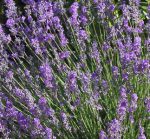 Although known as English lavender this strongly aromatic shrub is not native to England but to the western Mediterranean especially the Pyrenees and northern mountains of Spain. It is a member of the mint/deadnettle family, Lamiaceae, that also includes basil, rosemary, and beebalm. Plants grows into a mound about two to three feet high and as wide. The gray-green leaves are evergreen, one to two inches long, and narrow. The flowers are pinkish-purple and produced in whorls on leafless terminal spikes one to three inches long from late spring to early summer. Lavender is hardy in zones 5-8 and grows best in full sun and well-drained, neutral to alkaline soil, and tolerates drought. Propagation is usually by cuttings because seed germination is very slow. The genus name, Lavendula, comes from the Latin word lavo meaning wash and refers to the use of the plant is in toiletries. The specific epithet, angustifolia, is the Latin words angustus meaning narrow, and folia meaning leaf and refers to the appearance of the leaves.
Although known as English lavender this strongly aromatic shrub is not native to England but to the western Mediterranean especially the Pyrenees and northern mountains of Spain. It is a member of the mint/deadnettle family, Lamiaceae, that also includes basil, rosemary, and beebalm. Plants grows into a mound about two to three feet high and as wide. The gray-green leaves are evergreen, one to two inches long, and narrow. The flowers are pinkish-purple and produced in whorls on leafless terminal spikes one to three inches long from late spring to early summer. Lavender is hardy in zones 5-8 and grows best in full sun and well-drained, neutral to alkaline soil, and tolerates drought. Propagation is usually by cuttings because seed germination is very slow. The genus name, Lavendula, comes from the Latin word lavo meaning wash and refers to the use of the plant is in toiletries. The specific epithet, angustifolia, is the Latin words angustus meaning narrow, and folia meaning leaf and refers to the appearance of the leaves.
In ancient times lavender was valued for its scent and flavor as well as medicinal properties. The Egyptians used it for it in the mumification process, the Greeks considered it important as a holy herb and used it to anoint the feet. Both the Phoencians and Romans appreciated its scent and the Phoencians also used it in cooking while the Roman soldiers used it to heal wounds. The naturalist, Pliny the Elder mentions lavender as as a cure for several conditions including menstrual, stomach, and kidney problems, insect bites, and jaundice. During the Middle Ages lavender was a considered an herb of love, and in the Renaissance Queen Elizabeth I used lavender tea to sooth the effects of migraine headaches. In the US herbes de Provence often includes lavender along with savory, marjoram, rosemary, thyme, and oregano, a mixture that is good in stew as well as with grilled fish and meat.
I